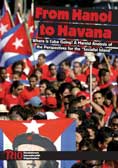




 The defining feature of the Cuban economy today is the blockade imposed by the United States government in 1962 under the “Trading with the Enemies Act”, tightened again in 1996 with the “Healms-Burton Act”. Cuban sources estimate that in the last fifty years the Cuban economy has lost roughly US$86 billion due to this blockade[38].
The defining feature of the Cuban economy today is the blockade imposed by the United States government in 1962 under the “Trading with the Enemies Act”, tightened again in 1996 with the “Healms-Burton Act”. Cuban sources estimate that in the last fifty years the Cuban economy has lost roughly US$86 billion due to this blockade[38].
Nonetheless, Cuba imports huge amounts of food from the United States. Cuba’s central historical problem, its lack of industrial development and its resultant dependence on sugar exports and tourism (which Che Guevara criticized when he resigned from the Cuban leadership), has meant that Cuba remains dependent on imports: from China, Europe, Canada and also from the US. In 2007, Cuba spent more than half a billion dollars on food imports from the US – despite the embargo which dictated unfavorable conditions for the Cuban side. Since Cuba’s agricultural sector produces just 20% of the population’s needs, the US is Cuba’s most important source of food[39].
While Cuba’s leadership exhorts the workers to “complain less and work more”[40], the fundamental problem is that a degenerate workers’ state can offer few incentives to the working class to increase productivity. It can only offer benefits or sanctions in a very limited way (i.e. it has few carrots and few sticks). As a result of this, there is the danger that industrious workers will see opportunities for advancement under a capitalist system and therefore also see their future there. Whereas a capitalist market relies on both the threat of unemployment and the promise of advancement, a bureaucratically planned economy is based on full employment and generalized poverty. The only sustainable mechanism for increasing productivity is a living workers’ democracy that draws the entire working population into the management of all aspects of political and economic life (and works to spread the revolution beyond the country’s borders).
The most recent economic reforms proposed by the Cuban government, which calls cuts in education and health care spending “unavoidable”[41], will further expand the private sector. There is currently an experiment to eliminate the 24,700 state canteens which provide a mid-day meal for 3.4 million workers. Workers will receive a coupon worth 15 pesos, to be spent in a private establishment, instead of food. If fully implemented, this reform will lead to an explosion of private businesses at the expense of state-run food distribution.
It is generally expected that the state food rations (“La Cartilla”), guaranteeing at least some basic provisions for the whole population, will be the next to go[42]. There are even reforms underway to allow private employment, reintroducing wage labor in order to provide jobs for up to one million state workers that the government considers superfluous[43]. The firing of up to 20% of the entire working class in Cuba could lead to a qualitative shift in the relationship between the state and private sectors of the economy.
Notes:
38. Granma: “U.S. has cost more than $86 billion”. Granma Internacional. October 4, 2006.
39. Bernd Bieberich: “Agonie auf dem Acker”. In: Lateinameria-Nachrichten. #415. January 2009. Berlin.
40. Diego Dalay: “Raúl Castro announces measures ‘not pleasant’ to the Cuban people.”
41. Ebd.
42. Rigoberto Díaz: “Los privados esperan aprovechar el cierre de comedores obreros en Cuba”.
43. Eduardo Molina: “Raúl announces an attack on the workers’ conquests”.
Leave a Reply
